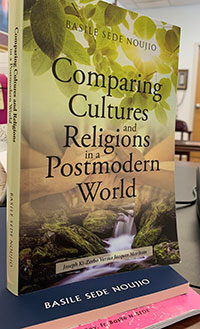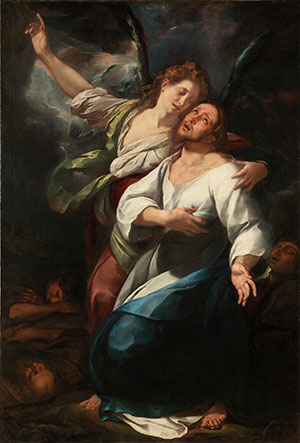
CHARLOTTE — Father Basile Sede, pastor of Our Lady of Consolation Church, has written a third book entitled “Comparing Cultures and Religions in a Postmodern World: Joseph Ki-Zerbo Versus Jaques Maritain.”
In his latest book, Father Sede illustrates how culture and religion are basic to every human society, and the history of a people always sustains its cultural and religious values.
“This book highlights the idea that every history is an embodiment of culture, tradition and religion,” Father Sede explains. “Globalization is bringing lots of challenges to the world today because, though people have different origins with different cultures and religions, they are conditioned by necessity to live together.
“Accordingly, some knowledge of the major world cultures and religions is truly relevant for peaceful co-existence.”
He notes that he decided to use African cultures and religious practices as his departing point “for the mere fact that Africa is generally considered as the cradle of civilization, and it is a very historic and controversial continent.”
“However, while examining some prominent world cultures and religions (in a comparative manner), my major focus is on the Christian-Thomistic culture and religion as illustrated by Jacques Maritain in comparison with the African culture and religion as expressed by Joseph Ki-Zerbo,” he explains.
Ki-Zerbo was a historian, politician and writer from Burkina Faso who is considered one of Africa’s foremost thinkers. Raised Catholic, he briefly trained for the priesthood before dropping out to study history and law at the Sorbonne. A socialist and an advocate of African independence and unity, he died in 2006.
Maritain was a Catholic convert and French philosopher who was one of the leading interpreters of St. Thomas Aquinas in the 20th century. A close friend of St. Paul VI, he also was influential in the development of the Universal Declaration of Human Rights. He died in 1973.
"While regretting that the world of today within our own eyes, in the name of development and civilization, is tending toward barbarianism at an accelerated speed, Jacques Maritain encourages the secularization of the human person, but a secularization that is spiced by Christian culture, not along the dictates of the state" Father Sede notes..
Father Sede asserts that both thinkers considered that amid ongoing multiculturalism and globalization, authentic humanism or personalism – based on the sacredness of the human person – should be endorsed as a new civilization or culture.
“Only such a culture can make the future of humankind essentially meaningful and interesting,” he says.
— SueAnn Howell, Senior reporter
The book is available online at www.amazon.com.
‘Christus am Ölberge’ voices suffering, prayer, and eventual peace
 Lent is meant to be a season of penance and reflection. Depending on the circumstances in which we find ourselves, some years can be starkly more poignant, when we have the opportunity to unite our own suffering with those of Christ’s. Such was the case for Ludwig van Beethoven (1770-1827), a Catholic who leaned on his faith throughout his life. His oratorio “Christus am Ölberge,” Op. 85 (1803), depicting the Agony of Christ in the Garden of Gethsemane, was composed not long after he learned that his deafness would get worse and there was no cure. The famous composer must have contemplated the cross he was being asked to bear – uniting himself to Christ’s own emotional agony.
Lent is meant to be a season of penance and reflection. Depending on the circumstances in which we find ourselves, some years can be starkly more poignant, when we have the opportunity to unite our own suffering with those of Christ’s. Such was the case for Ludwig van Beethoven (1770-1827), a Catholic who leaned on his faith throughout his life. His oratorio “Christus am Ölberge,” Op. 85 (1803), depicting the Agony of Christ in the Garden of Gethsemane, was composed not long after he learned that his deafness would get worse and there was no cure. The famous composer must have contemplated the cross he was being asked to bear – uniting himself to Christ’s own emotional agony.
An oratorio is a genre with its roots in Baroque Italy that served as a substitution for opera, which was banned during Advent and Lent in Catholic regions. The subject of early oratorios often presented a story of sacrifice to complement the penitential seasons – for example, Giacomo Carissimi’s “Jephte,” where the title character sacrifices his daughter as told in the Book of Judges. The word “oratorio” comes from the prayer halls, or oratories, where such works were initially performed. By Beethoven’s time, oratorios kept the religious texts but had moved to the concert stage.
Beethoven was trained from an early age to be a professional musician, beginning piano lessons so young he had to stand on the bench to even reach the keys. By the time he moved to Vienna, he was becoming famous as a virtuoso pianist and improvisor.
He started losing his hearing in 1797 and within a few years, it was evident the condition was worsening. Trained in only one way to support himself, he feared that the loss of his hearing would be catastrophic. In 1802, he penned the heartbreaking “Heiligenstadt Testament,” a letter to his brothers to be read after his death that detailed the emotional anguish and isolation in which he found himself. The letter dates to the year prior to “Christus am Ölberge,” and thus, the connection between the suffering of Christ and his own make the work all the more powerful.
“Christus am Ölberge” was composed quickly in a few weeks. It is scored for orchestra, chorus and three soloists: Soprano (Seraph), Tenor (Christ), and Bass (Peter). Following an orchestral introduction, the opening recitative and aria depict Christ’s agony and emotional prayer in the garden. The English translation, by Timothy Adès in the 2020 recording by Sir Simon Rattle and the London Symphony Orchestra, reads:
“Jehovah! My Father! Send me strength and solace. The hour of my Passion draws near. I chose it, before the world was formed at your command. I hear your Seraph’s voice of thunder calling. Who will stand in Man’s place before your judgment? Here am I to intercede. I alone expiate the guilt of men.
How could this race, made from dust, endure a judgment that bears me, your Son, to the ground? See how my heart is wracked by sorrow and mortal dread. Father, I suffer! Have mercy on me!”
The aria begins in the key of C minor – a tonality frequently found in Beethoven’s dramatic works (such as the famous Fifth Symphony). The orchestral notes move quickly to paint the trembling soul of our Lord. Christ’s anxiety is described in text as well as in music through the fast, nervous melodies and simmering orchestral passages below.
The section peaks in volume and tension describing the blood He is sweating (“Blut”). The subsequent passage substitutes the anxious mood with a plea by Christ asking His Father to “take this cup of suffering (‘Leidenskelch’) from me.” Both sections of text are repeated, but in the final utterance of “Leidenskelch,” Beethoven composes an ornate melisma to highlight the cup of suffering – one he knew all too well.
Although the text was arranged by Franz Xaver Huber, Beethoven could scarcely have missed the parallels between his own intense suffering and eventual peace with that of his Savior’s.
What is particularly fascinating about this aria is that the listener is experiencing not only the human side of Christ with the anxiety and desperation that accompanies the trials of mortal life, but simultaneously Beethoven’s. Anyone who has suffered prolonged physical, mental or spiritual agony will be able to relate to this theme in “Christus am Ölberge.”
Deacon Dr. David Ramsey, who serves at St. Francis of Assisi Parish in Franklin and also works as a physician, comments on Beethoven’s loss of hearing:
“Reflecting on my own hearing loss, I can fully empathize with the impact on this great composer of the critical loss of his sense of hearing. With my new hearing aids, I can appreciate again hearing birds chirp and the sound of gravel under my feet. Over the years I have had the privilege of treating and sharing in the sufferings of many ailments with my patients, and been there with those who have died. Lent highlights our mortality as ashes are placed on our heads and the priest or deacon refrains, ‘Remember that you are dust, and to dust you shall return.’ Jesus broke this barrier of death by His Passion, death and Resurrection for us. In the Holy Sacrifice of the Mass, the great prayer of the Church, we experience Jesus uniting Himself with us in our humanity, as we unite with Him in His divinity. While suffering through the rapid loss of his hearing, Beethoven wrote one of his greatest works, ‘Missa Solemnis,’ to the glory of the Mass. At the ‘Sanctus’ a solo violin plays at its highest range, representing the Holy Spirit. Despite reports of Beethoven’s wavering from the faith, he received the last rites, the anointing of the sick, and a Catholic funeral Mass. It is through our steadfast devotions as Catholic Christians that we are offered the assured hope through Christ of eternal life.”
— Christina L. Reitz, Ph.D., Special to the Catholic News Herald. Christina L. Reitz, Ph.D., is professor of music at Western Carolina University in Cullowhee.
Listen online
Listen to the first aria of Beethoven’s “Christus am Ölberge” (“Christ on the Mount of Olives”)

